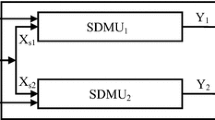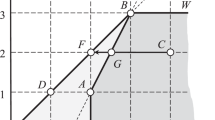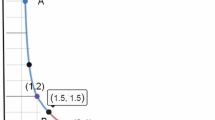Abstract
This chapter discusses the use of DEA models with weight restrictions for purposes of benchmarking and target setting. Weight restrictions have been used in the literature to incorporate into the analysis both value judgments (managerial preferences or prior views about the relative worth of inputs and outputs) and technological judgments (assumptions on production trade-offs). An important consideration in the use of restricted models for the benchmarking is that they may provide targets that are outside the production possibility set (PPS). Such difficulties are overcome if weight restrictions represent production trade-offs, because in those cases restricted models lead to a meaningful expansion of the production technology. However, if weight restrictions are only used as a way of incorporating preferences or value judgments, then there could be no reason to consider the targets derived from those models as attainable. Despite the classical restricted DEA formulations may yield targets within the PPS, it is claimed here that an approach based on a more appropriate selection of benchmarks would be desirable. We develop some restricted models which provide the closest targets within the PPS that are Pareto-efficient. Thus, if weight restrictions represent value judgments, the proposed approach allows us to identify best practices which show the easiest way for improvement and are desirable (in the light of prior knowledge and expert opinion) in addition to technically achievable.
Access this chapter
Tax calculation will be finalised at checkout
Purchases are for personal use only
Similar content being viewed by others
Notes
- 1.
- 2.
- 3.
Credit is the unit of measurement of the academic load of the subject of a programme.
References
Adler N, Liebert V, Yazhemsky E (2013) Benchmarking airports from a managerial perspective. Omega 41(2):442–458
Allen R, Athanassopoulos A, Dyson RG, Thanassoulis E (1997) Weights restrictions and value judgments in data envelopment analysis: evolution development and future directions. Ann Oper Res 73:13–34
Aparicio J, Pastor JT (2014) Closest targets and strong monotonicity on the strongly efficient frontier in DEA. Omega (United Kingdom) 44:51–57
Aparicio J, Ruiz JL, Sirvent I (2007) Closest targets and minimum distance to the Pareto-efficient frontier in DEA. J Prod Anal 28(3):209–218
Atici KK, Podinovski VV (2015) Using data envelopment analysis for the assessment of technical efficiency of units with different specialisations: an application to agriculture. Omega 54:72–83
Banker RD, Charnes A, Cooper WW (1984) Some models for estimating technical and scale inefficiencies in data envelopment analysis. Manage Sci 30:1078–1092
Beale EML, Tomlin JA (1970) Special facilities in a general mathematical programming system for non-convex problems using ordered sets of variables. In: Lawrence J (ed). Proceedings of the fifth international conference on operational research. Tavistock Publications, London, pp 447–454
Beasley JE (1990) Comparing university departments. Omega 18(2):171–183
Charnes A, Cooper WW (1962) Programming with linear fractional functionals. Naval Res. Logistics Q 9(3–4):181–186
Charnes A, Cooper WW, Rhodes E (1978) Measuring the efficiency of decision making units. Eur J Oper Res 2(6):429–444
Charnes A, Cooper WW, Thrall RM (1986) Classifying and characterizing inefficiencies in data envelopment analysis. Oper Res Lett 5(3):105–110
Charnes A, Cooper WW, Golany B, Seiford L, Stutz J (1985) Foundations of data envelopment analysis for Pareto-Koopmans efficient empirical productions functions. J Econometrics 30(1–2):91–107
Charnes A, Cooper WW, Golany B, Seiford L, Stutz J (1987) A dimensionless efficiency measure for departures from pareto optimality. Research report CCS 480, center for cybernetic studies. The University of Texas, Austin
Charnes A, Cooper WW, Huang ZM, Sun DB (1990) Polyhedral cone-ratio DEA models with an illustrative application to large commercial banks. J Econometrics 46(1):73–91
Charnes A, Cooper WW, Lewin AY, Seiford LW (1994) Data envelopment analysis: theory, methodology and applications. Kluwer Academic Publishers, Germany
Cook WD, Tone K, Zhu J (2014) Data envelopment analysis: prior to choosing a model. Omega 44:1–4
Cooper WW, Pastor JT, Borrás F, Aparicio J, Pastor D (2011a) BAM: a bounded adjusted measure of efficiency for use with bounded additive models. J Prod Anal 35(2):85–94
Cooper WW, Park KS, Pastor JT (1999) RAM: a range adjusted measure of inefficiency for use with additive models, and relations to other models and measures in DEA. J Prod Anal 11(1), 5–42
Cooper WW, Seiford LM, Tone K (2007) Data envelopment analysis: a comprehensive text with models, applications, references and DEA-solver software, 2nd edn. Springer Science & Business Publishers, New York
Cooper WW, Ruiz JL, Sirvent I (2009) Selecting non-zero weights to evaluate effectiveness of basketball players with DEA. Eur J Oper Res 195(2):563–574
Cooper WW, Ruiz JL, Sirvent I (2011b) Choices and uses of DEA weights. In: Cooper WW, Seiford LW, Zhu J (eds) Handbook on data envelopment analysis. Springer, Berlin, pp 93–126
Dai X, Kuosmanen T (2014) Best-practice benchmarking using clustering methods: application to energy regulation. Omega 42(1):179–188
Fukuyama H, Maeda Y, Sekitani K, Shi J (2014) Input–output substitutability and strongly monotonic p-norm least distance DEA measures. Eur J Oper Res 237(3):997–1007
Hung SW, Lu WM, Wang TP (2010) Benchmarking the operating efficiency of Asia container ports. Eur J Oper Res 203(3):706–713
Lins MPE, Sollero MKV, Calôba GM, da Silva ACM (2007) Integrating the regulatory and utility firm perspectives, when measuring the efficiency of electricity distribution. Eur J Oper Res 181(3):1413–1424
Lovell CAK, Pastor JT (1995) Units invariant and translation invariant DEA models. Oper Res Lett 18(3):147–151
Podinovski VV (2004) Production trade-offs and weight restrictions in data envelopment analysis. J Oper Res Soc 55(12):1311–1322
Podinovski VV (2007a) Improving data envelopment analysis by the use of production trade-offs. J Oper Res Soc 58(10):1261–1270
Podinovski VV (2007b) Computation of efficient targets in DEA models with production trade-offs and weight restrictions. Eur J Oper Res 181(2):586–591
Podinovski VV (2015) DEA models with production trade-offs and weight restrictions. In: Zhu J (ed.) Data envelopment analysis: a handbook of models and methods. Springer, Berlin, pp 105–144
Portela MCAS, Borges PC, Thanassoulis E (2003) Finding closest targets in non-oriented DEA models: the case of convex and non-convex technologies. J Prod Anal 19(2–3):251–269
Portela MCAS, Camanho AS, Borges D (2012) Performance assessment of secondary schools: the snapshot of a country taken by DEA. J Oper Res Soc 63(8):1098–1115
Ruiz JL, Segura JV, Sirvent I (2015) Benchmarking and target setting with expert preferences: an application to the evaluation of educational performance of Spanish universities. Eur J Oper Res 242(2):594–605
Ruiz JL, Sirvent I (2016) Common benchmarking and ranking of units with DEA. Omega 65:1–9
Saaty TL (1980) The analytic hierarchy process. McGraw-Hill International Book Company, USA
Thanassoulis E, Portela MCAS, Allen R (2004) Incorporating value judgments in DEA. In: Cooper WW, Seiford LW, Zhu J (eds) Handbook on data envelopment analysis. Kluwer Academic Publishers, Boston
Thanassoulis E, Portela MCAS, Despić O (2008) Data envelopment analysis: the mathematical programming approach to efficiency analysis. In: Harold, OF, Knox Lovell CA, Schmidt SS (eds.), The measurement of productive efficiency and productivity growth. Oxford University Press, New York, NY (US)
Thompson RG, Singleton FD, Thrall RM, Smith BA (1986) Comparative site evaluations for locating a high-energy physics lab in Texas. Interfaces 16(6):35–49
Thrall RM (1996) Duality, classification and slacks in DEA. Ann Oper Res 66(2):109–138
Thrall RM (2000) Measures in DEA with an Application to the Malmquist Index. J Prod Anal 13(2):125–137
Tone K (2010) Variations on the theme of slacks-based measure of efficiency in DEA. Eur J Oper Res 200(3):901–907
Wong Y-HB, Beasley JE (1990) Restricting weight flexibility in data envelopment analysis. J Oper Res Soc 41(9):829–835
Zanella A, Camanho AS, Dias TG (2013) Benchmarking countries environmental performance. J Oper Res Soc 64(3):426–438
Author information
Authors and Affiliations
Corresponding author
Editor information
Editors and Affiliations
Rights and permissions
Copyright information
© 2016 Springer International Publishing AG
About this chapter
Cite this chapter
Ramón, N., Ruiz, J.L., Sirvent, I. (2016). On the Use of DEA Models with Weight Restrictions for Benchmarking and Target Setting. In: Aparicio, J., Lovell, C., Pastor, J. (eds) Advances in Efficiency and Productivity. International Series in Operations Research & Management Science, vol 249. Springer, Cham. https://doi.org/10.1007/978-3-319-48461-7_7
Download citation
DOI: https://doi.org/10.1007/978-3-319-48461-7_7
Published:
Publisher Name: Springer, Cham
Print ISBN: 978-3-319-48459-4
Online ISBN: 978-3-319-48461-7
eBook Packages: Economics and FinanceEconomics and Finance (R0)




